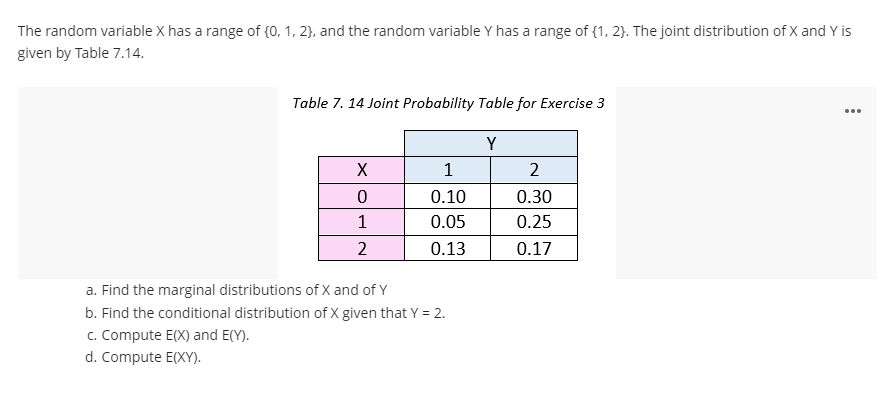The random variable X has a range of {0, 1, 2}, and the random variable Y has a range of (1, 2). The joint distribution of X and Y is given by Table 7.14. Table 7. 14 Joint Probability Table for Exercise 3 Y 1 2 0.10 0.30 1 0.05 0.25 2 0.13 0.17 a. Find the marginal distributions of X and of Y b. Find the conditional distribution of X given that Y = 2. c. Compute E(X) and E(Y).
The random variable X has a range of {0, 1, 2}, and the random variable Y has a range of (1, 2). The joint distribution of X and Y is given by Table 7.14. Table 7. 14 Joint Probability Table for Exercise 3 Y 1 2 0.10 0.30 1 0.05 0.25 2 0.13 0.17 a. Find the marginal distributions of X and of Y b. Find the conditional distribution of X given that Y = 2. c. Compute E(X) and E(Y).
College Algebra
7th Edition
ISBN:9781305115545
Author:James Stewart, Lothar Redlin, Saleem Watson
Publisher:James Stewart, Lothar Redlin, Saleem Watson
Chapter9: Counting And Probability
Section9.3: Binomial Probability
Problem 2E: If a binomial experiment has probability p success, then the probability of failure is...
Related questions
Question

Transcribed Image Text:The random variable X has a range of {0, 1, 2), and the random variable Y has a range of {1, 2}. The joint distribution of X and Y is
given by Table 7.14.
Table 7. 14 Joint Probability Table for Exercise 3
...
Y
1
2
0.10
0.30
1
0.05
0.25
2
0.13
0.17
a. Find the marginal distributions of X and of Y
b. Find the conditional distribution of X given that Y = 2.
c. Compute E(X) and E(Y).
d. Compute E(XY).
Expert Solution
This question has been solved!
Explore an expertly crafted, step-by-step solution for a thorough understanding of key concepts.
Step by step
Solved in 4 steps with 2 images

Recommended textbooks for you

College Algebra
Algebra
ISBN:
9781305115545
Author:
James Stewart, Lothar Redlin, Saleem Watson
Publisher:
Cengage Learning

College Algebra
Algebra
ISBN:
9781305115545
Author:
James Stewart, Lothar Redlin, Saleem Watson
Publisher:
Cengage Learning